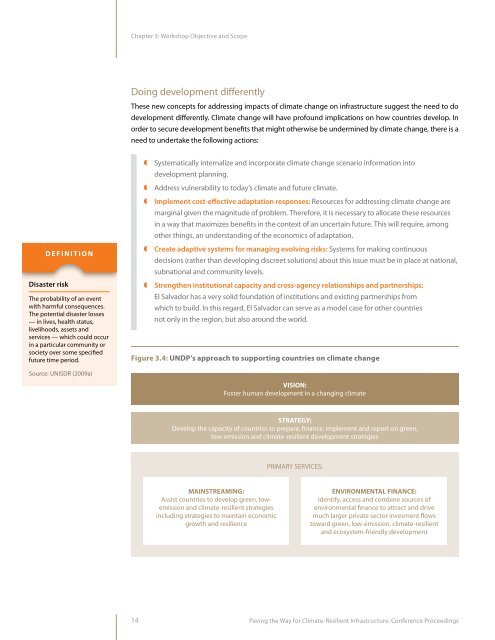Paving the Way for Climate-Resilient Infrastructure - UN CC:Learn
Paving the Way for Climate-Resilient Infrastructure - UN CC:Learn
Paving the Way for Climate-Resilient Infrastructure - UN CC:Learn
You also want an ePaper? Increase the reach of your titles
YUMPU automatically turns print PDFs into web optimized ePapers that Google loves.
Chapter 3: Workshop Objective and ScopeDoing development differentlyThese new concepts <strong>for</strong> addressing impacts of climate change on infrastructure suggest <strong>the</strong> need to dodevelopment differently. <strong>Climate</strong> change will have profound implications on how countries develop. Inorder to secure development benefits that might o<strong>the</strong>rwise be undermined by climate change, <strong>the</strong>re is aneed to undertake <strong>the</strong> following actions:Systematically internalize and incorporate climate change scenario in<strong>for</strong>mation intodevelopment planning.Address vulnerability to today’s climate and future climate.Implement cost-effective adaptation responses: Resources <strong>for</strong> addressing climate change aremarginal given <strong>the</strong> magnitude of problem. There<strong>for</strong>e, it is necessary to allocate <strong>the</strong>se resourcesin a way that maximizes benefits in <strong>the</strong> context of an uncertain future. This will require, amongo<strong>the</strong>r things, an understanding of <strong>the</strong> economics of adaptation.D E F I N I T I O NDisaster riskThe probability of an eventwith harmful consequences.The potential disaster losses— in lives, health status,livelihoods, assets andservices — which could occurin a particular community orsociety over some specifiedfuture time period.Create adaptive systems <strong>for</strong> managing evolving risks: Systems <strong>for</strong> making continuousdecisions (ra<strong>the</strong>r than developing discreet solutions) about this issue must be in place at national,subnational and community levels.Streng<strong>the</strong>n institutional capacity and cross-agency relationships and partnerships:El Salvador has a very solid foundation of institutions and existing partnerships fromwhich to build. In this regard, El Salvador can serve as a model case <strong>for</strong> o<strong>the</strong>r countriesnot only in <strong>the</strong> region, but also around <strong>the</strong> world.Figure 3.4: <strong>UN</strong>DP’s approach to supporting countries on climate changeSource: <strong>UN</strong>ISDR (2009a)VISION:Foster human development in a changing climateSTRATEGY:Develop <strong>the</strong> capacity of countries to prepare, finance, implement and report on green,low-emission and climate-resilient development strategiesPRIMARY SERVICES:MAINSTREAMING:Assist countries to develop green, lowemissionand climate-resilient strategiesincluding strategies to maintain economicgrowth and resilienceENVIRONMENTAL FINANCE:Identify, access and combine sources ofenvironmental finance to attract and drivemuch larger private sector invesment flowstoward green, low-emission, climate-resilientand ecosystem-friendly development14<strong>Paving</strong> <strong>the</strong> <strong>Way</strong> <strong>for</strong> <strong>Climate</strong>-<strong>Resilient</strong> <strong>Infrastructure</strong>: Conference Proceedings
















